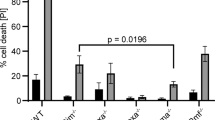Abstract
The interleukin-3 dependent murine Ba/F3 cell line has been widely used as an experimental model of cell transformation by BCR – ABL oncogenes as assessed by induction of growth-factor-independence and inhibition of apoptosis in vitro. The signaling pathways used by BCR – ABL oncogenes to exert these effects are unknown. To gain insights into this phenomenon, we have introduced the p190- and p210-encoding BCR – ABL oncogenes as well as the constitutively activated oncogenic murine erythropoietin receptor (cEpoR) into Ba/F3 and compared the behavior of individual clones in response to apoptotic stimuli. Both p210 and p190 BCR – ABL vectors induced IL-3-independent growth and the same result was obtained with the cEpo-R vector. Individual clones of Ba/F3 cells expressing BCR – ABL exhibited significant resistance to apoptosis induced by either etoposide, serum deprivation or growth-factor withdrawal. In contrast, Ba/F3 cells expressing the constitutively active cEpoR behaved like parental Ba/F3 cells undergoing apoptosis when similarly treated with etoposide or upon serum deprivation. Bc12 and Bax levels were similar in all BCR – ABL and cEpoR-transfected clones. However, in band-shift assays, nuclear extracts from growth-factor-independent Ba/F3 clones expressing cEpoR had no detectable STAT activity as opposed to the constitutive STAT activation detected in all Ba/F3 clones expressing p210 or p190 BCR – ABL. Our results indicate that although both constitutively activated cEpoR and BCR – ABL oncogenes induce growth-factor independence in Ba/F3 cells, only BCR – ABL is able to protect cells from etoposide and serum-deprivation-induced apoptosis and induce a strong constitutive activation of STAT factors, suggesting a role for these molecules in the anti-apoptotic activity of BCR – ABL.
This is a preview of subscription content, access via your institution
Access options
Subscribe to this journal
Receive 50 print issues and online access
$259.00 per year
only $5.18 per issue
Buy this article
- Purchase on Springer Link
- Instant access to full article PDF
Prices may be subject to local taxes which are calculated during checkout
Similar content being viewed by others
Author information
Authors and Affiliations
Rights and permissions
About this article
Cite this article
Ahmed, M., Dusanter-Fourt, I., Bernard, M. et al. BCR-ABL and constitutively active erythropoietin receptor (cEpoR) activate distinct mechanisms for growth factor-independence and inhibition of apoptosis in Ba/F3 cell line. Oncogene 16, 489–496 (1998). https://doi.org/10.1038/sj.onc.1201556
Received:
Revised:
Accepted:
Published:
Issue Date:
DOI: https://doi.org/10.1038/sj.onc.1201556
Keywords
This article is cited by
-
Tyrosine kinase inhibitor AG1024 exerts antileukaemic effects on STI571-resistant Bcr-Abl expressing cells and decreases AKT phosphorylation
British Journal of Cancer (2004)
-
Constitutive and specific activation of STAT3 by BCR-ABL in embryonic stem cells
Oncogene (2003)
-
Rapid generation of a tetracycline-inducible BCR-ABL defective retrovirus using a single autoregulatory retroviral cassette
Leukemia (2001)
-
Tumor-derived exosomes are a source of shared tumor rejection antigens for CTL cross-priming
Nature Medicine (2001)
-
The leukaemic oncoproteins Bcr-Abl and Tel-Abl (ETV6/Abl) have altered substrate preferences and activate similar intracellular signalling pathways
Oncogene (2000)



